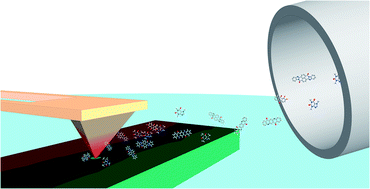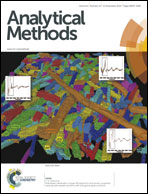Sub-micron proximal probe thermal desorption and laser mass spectrometry on painting cross-sections
Abstract
We demonstrate sub-micron, atomic force microscopy (AFM) proximal probe desorption of organic dyes, and subsequent detection via laser mass spectrometry. A nanothermal analysis (nano-TA) probe tip in contact with a surface is heated (10 000 °C s−1) to induce thermal desorption, creating depression sizes ranging from 360–1500 nm in diameter and 20–100 nm in depth. Desorbed material is drawn through a heated capillary via vacuum, and deposits onto a graphite sample bar. Laser desorption, followed by supersonic jet-cooling and either resonant two-photon ionization (R2PI) or non-resonant ionization mass spectrometry is used to characterize the transferred material. Individual, microscopic layers of organic dyes within painting cross-sections were successfully analyzed using this new approach. Separating the AFM thermal desorption step from the detection step allows for the use of analytical techniques appropriate for individual samples of material, desorbed with high spatial resolution.


 Please wait while we load your content...
Please wait while we load your content...